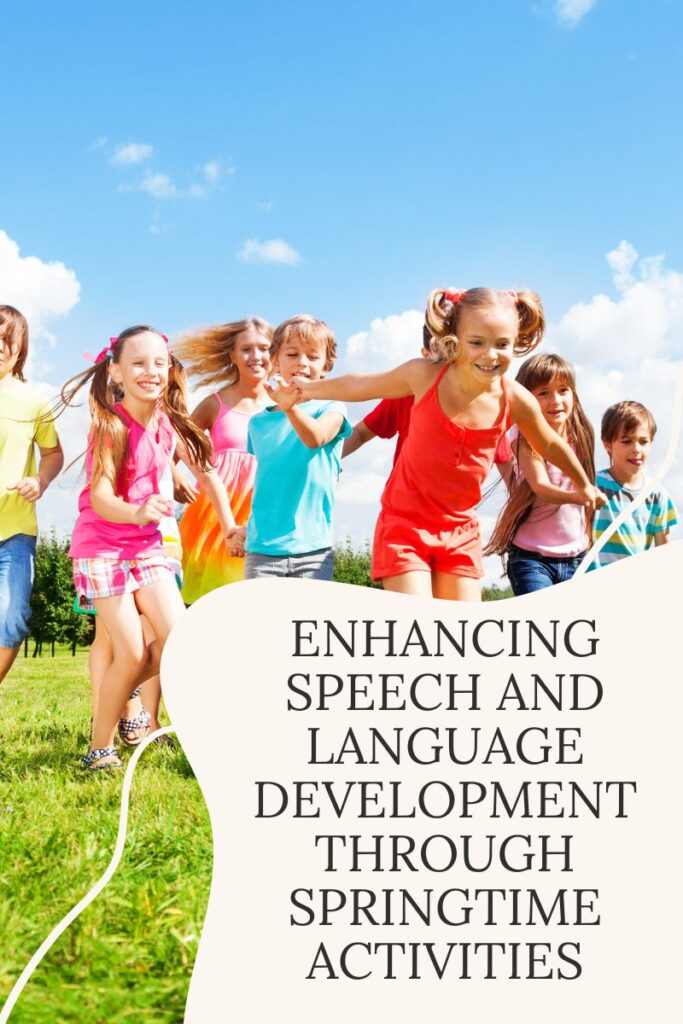
This blog will cover a brief overview of speech and language development. It will also highlight fun and functional ways for you to grow speech, language and communication skills at home.
Check out the rest of the blog for ideas, especially for early intervention, and at home strategies.
*speech and language fundamentals
*8 fun and functional springtime activities to grow communication skills
A Guide to Early Intervention Introduction:
Springtime offers a plethora of opportunities to engage children in stimulating activities that promote speech and language development. Early intervention is crucial in supporting children with speech and language delays, and what better way to incorporate intervention than through fun and interactive springtime activities? In this blog, we’ll explore how parents, educators, and caregivers can utilize the vibrant season of spring to enhance speech and language skills in children.
Understanding Speech and Language Development:
Before diving into activities, it’s essential to understand the fundamentals of speech and language development. Speech refers to the physical act of producing sounds, while language encompasses the comprehension and use of words and sentences to communicate ideas. Both aspects are vital for effective communication and social interaction. Early Intervention in Speech and Language:
Early intervention plays a pivotal role in addressing speech and language delays. By identifying and addressing challenges early on, children can develop stronger communication skills, leading to improved academic performance and social interactions. Springtime provides an ideal backdrop for implementing early intervention strategies, as the season offers various sensory experiences and opportunities for engagement.
Springtime Activities for Speech and Language Development:
1. **Nature Walks and Scavenger Hunts**: Take advantage of the blooming flowers, chirping birds, and buzzing insects by going on nature walks or scavenger hunts. Encourage children to describe what they see, hear, and feel, fostering vocabulary development and descriptive language skills. Can the child point to/name what you find?
2. **Picnics and Outdoor Storytime**: Organize picnics in the park or backyard and bring along books for outdoor storytime. Use this opportunity to introduce new words, engage in conversations about the story, and encourage children to retell the plot using their own words.Practice sequencing the events to prepare and unpack with vocabulary words.
3. **Gardening and Planting Activities**: Get your hands dirty with gardening activities such as planting seeds, watering plants, and observing growth. This hands-on experience not only teaches children about nature but also provides opportunities to learn new words related to plants, gardening tools, and the growth process. Great opportunity for actions words at well: digging, planting, watering, etc. Choose words that you don’t use everyday for new practice.
4. **Arts and Crafts with a Spring Theme**: Engage children in arts and crafts projects inspired by spring, such as making flower crowns, painting birdhouses, or creating butterfly-shaped artwork. Encourage verbal expression by discussing the creative process, describing colors and textures, and narrating the story behind their artwork. Endless language opportunities with this!
5. **Outdoor Games and Sports**: Organize outdoor games and sports activities like tag, hopscotch, or soccer, promoting social interaction and communication skills. Encourage turn-taking, following instructions, and verbalizing strategies during gameplay.
6. **Springtime Cooking and Baking**: Whip up delicious treats using seasonal ingredients like strawberries, carrots, or fresh herbs. Cooking and baking activities provide opportunities for following recipes, sequencing steps, and describing tastes and textures.
7. **Spring-themed Sensory Play**: Set up sensory bins filled with materials like flower petals, birdseed, or colored rice for sensory exploration. Encourage children to use descriptive language to express their sensory experiences, such as soft, crunchy, or fragrant.
8. **Outdoor Music and Movement Activities**: Explore rhythm and movement outdoors with activities like singing songs, dancing to music, or playing musical instruments. Encourage children to sing along, clap to the beat, and express themselves through movement. Conclusion: Springtime serves as a vibrant backdrop for fostering speech and language development in children through engaging and interactive activities.
By incorporating these activities into daily routines, parents, educators, and caregivers can provide early intervention support that enhances communication skills and fosters social interaction. Remember, every interaction is an opportunity for learning and growth, so seize the magic of springtime to nurture the speech and language skills of the children in your care.
